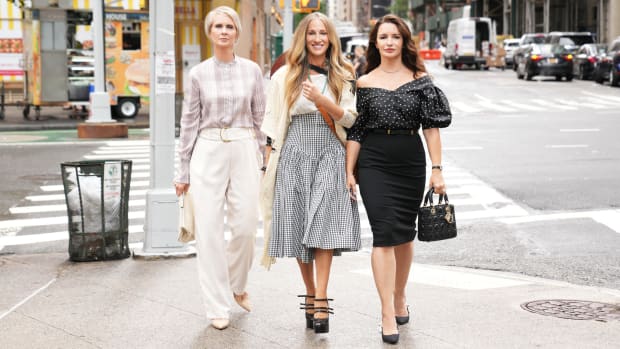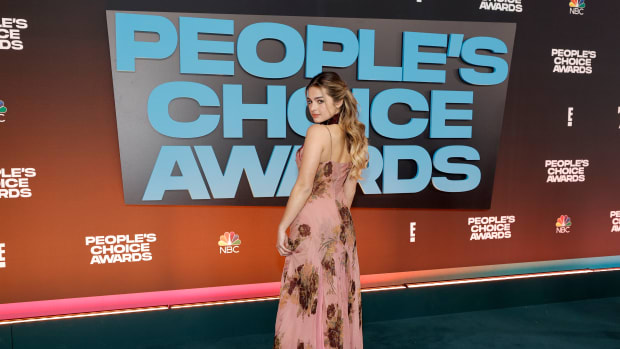I was in high school when I started watching "Sex and the City." It would be many years before I'd experience anything similar to what Carrie Bradshaw wrote about in her
fictional column, but I was obsessed, and I'll go ahead and embarrass myself by admitting that I desperately wanted to be her. While I did wind up achieving the whole living in New York/drinking cocktails/smoking cigarettes/becoming a writer thing, I still lacked the confidence to embrace one of the protagonist's most defining characteristics: curly hair. I straightened my own from the early 2000s up until last year.
I've rewatched the series countless times, often noticing new things, like how Justin Theroux plays two different love interests, or how Carrie doesn't own a couch, or how much of the script I've committed to memory (a disturbing amount). As I've gotten older, I'll find I relate more to themes I hadn't fully grasped before, or get a weird sense relief upon realizing that Carrie didn't really have her finances or love life together in her 30s either (then I'll also remind myself that she's not really someone I should look up to). But on my most recent rewatch, I was preoccupied with something more superficial: Carrie's hair. And I say Carrie's because I've come to realize that Carrie's hair and Sarah Jessica Parker's hair are two different things.
Since transitioning from chemically straightened hair to my natural curls, I've developed a fixation with hair texture. I obsessively research products, consume YouTube videos and articles, listen extra carefully anytime curls come up on the "Poog" podcast and closely examine photos of fellow curl-havers, be they friends, celebrities or people I follow on Instagram.
And during my latest viewings of "SATC," particularly the first three seasons, I came to realize that Carrie is really one of the best representations of curly hair we have in mainstream media. Not only did she flaunt her "c-c-c-curly" hair in an era of stick-straight, flat-ironed 'dos, but she did so as a sex symbol and one of the most stylish women in New York (and on television). Better yet, her curls were imperfect and untamed: They were often frizzy, or dry, or a little poufy, or a little flat. Her roots would show. She'd throw her hair up in a messy bun that actually looked like she did it herself. Her seemingly effortless approach to hair made her more relatable, and watching this very old show now has made me feel more confident in my hair today.
In retrospect, it actually feels kind of radical. It's been more than 20 years since "SATC" first aired and I still can't think of many other examples in pop culture of someone who is representative of style and sophistication embracing her curly, frizzy hair. In fact, what I've seen is a lot of reinforcement of the idea that textured hair is antithetical to style and sophistication.
The most famous example is Mia Thermopolis in 2001's "The Princess Diaries," played by Anne Hathaway. The film features a classic teen-movie makeover, where a conventionally attractive actress goes from "ugly" to beautiful by removing her glasses and styling her hair differently. In Thermopolis's case, the transformation relied upon straightening her frizzy, curly head of hair, which is deemed difficult and unattractive: a message that many of the the film's impressionable young viewers no doubt internalized.
In 1995's "Clueless," while Brittany Murphy-as-Tai still has "curly tendrils" post-makeover, rollers are used to take them from untamed and frizzy to perfect and shiny. On "The Today Show"'s weekly ambush makeovers, Louis Licari has a history of defaulting to straightening subjects' hair. Meanwhile, many celebrities have abandoned their curls over the years, from Keri Russell to Julia Roberts to Taylor Swift.
I'm half Black, and I wasn't seeing much aspirational natural-hair representation in Black film and television, either. Of course, in the Black community, the topic of hair texture is more complex and political; hair discrimination in professional settings is still a pressing issue. Still, Tracee Ellis Ross as Joan Clayton in "Girlfriends" deserves a mention here. Unfortunately it wasn't on my radar when it was first on the air, but bingeing the sitcom during lockdown gave me even more curly-hair inspiration and confidence.
On "SATC," Carrie wears her hair curly pretty consistently in the first three seasons. She might straighten it for fun here and there, but her wild hair is still as much a part of her as her Marlboro Lights. However, around the same time Aidan motivates her to swap cigs for patches, her hair starts to undergo an odd transformation.
Recommended Articles
In season four, it's looking a little darker, shorter, flatter, smoother and shaggier, and she often wears it half up or slicked back. According to hairstylists who worked on the show at the time, there was a reason for this: After years of bleaching her brunette locks, Parker underwent one highlight job too many and much of her hair broke off before shooting began; their only option was to drench her hair in conditioner and tie it back. That was the real impetus for the dramatic chop we see halfway through the season. (No, it was not Carrie's breakup with Aidan or new freelance gig at Vogue.) This was the beginning of the end of Carrie's hair as we knew it.
Through season five, its texture ran the gamut from stick-straight, to softly blown out, to Shirley Temple ringlets, to subtle waves — which is actually a relatable way to deal with that awkward growing-out period. It's also worth noting that Parker's natural hair is actually more wavy than curly, and stylists apparently used curling irons of various sizes to achieve Carrie's signature look.
As Parker's hair grew back, Carrie's gradually morphed into an editorialized idea of wavy hair, a texture that, to my knowledge, has never once actually grown out of a person's head. You know the look: long, smooth, uniform waves made up largely by extensions and sported by just about every modern female TV protagonist ever. This was Carrie's look as an American in Paris, as a bride-to-be, as a woman who ditched her own wedding and sunk into a depression over what amounted to a simple misunderstanding, and as a woman who took a ridiculous girls' trip to Abu Dhabi.
I didn't really care. To me, the movies weren't the real "SATC." But for some reason, when a small-screen sequel was announced, I felt optimistic that big budgets, outlandish plots and slapstick comedy would be replaced by a nostalgic return to the original show's classic format — hair included. But "And Just Like That..." paparazzi photos have confirmed otherwise. It's back to those boring, uniform waves, it seems. I'm a little crushed.
To be fair, no one's hair is going to look the same in their 50s as it did in their early 30s (unless they're Connie Britton), and I appreciate the grays peeking out from beneath Carrie's highlights. But at the end of the day, is she just another Mia Thermopolis? It's hard to ignore the fact that all four main characters "glow up" as the franchise progresses: As they get what they want out of life, be it career success, nicer apartments, kids or husbands, they begin to look more polished, wearing more expensive clothes, with hair and makeup that appears professionally done and skin that looks like it's been cared for by a top cosmetic dermatologist. Everything starts to feel more glossy and perfect.
Times change, and there are a lot of moments in the original "SATC" that didn't age well. While Carrie might still bring out shoes and handbags from her younger years and return to her old little couch-free apartment for nostalgia's sake in the new series, there's no way the show's writers would reintroduce her smoking habit or dismissal of bisexuality; and apparently her old hair texture is also a relic of the past.
Fortunately, we can redirect our attention to the next generation. A new wave of stars are being given the opportunity to make textured hair aspirational again, from Zendaya and Yara Shahidi, to "Insecure"'s Issa Rae and Yvonne Orji, to "Gossip Girl"'s Savannah Lee Smith and Whitney Peak. Meanwhile, girls on TikTok are plopping their way to viral spirals and we're seeing more natural textures on reality shows and fashion-week runways than ever.
Obviously, people have the freedom to style their hair however they please, but the more hair diversity we see in media, the faster we can undo all the damage done by flat irons, toxic chemicals and Mia Thermopolis.
Never miss the latest fashion industry news. Sign up for the Fashionista daily newsletter.










